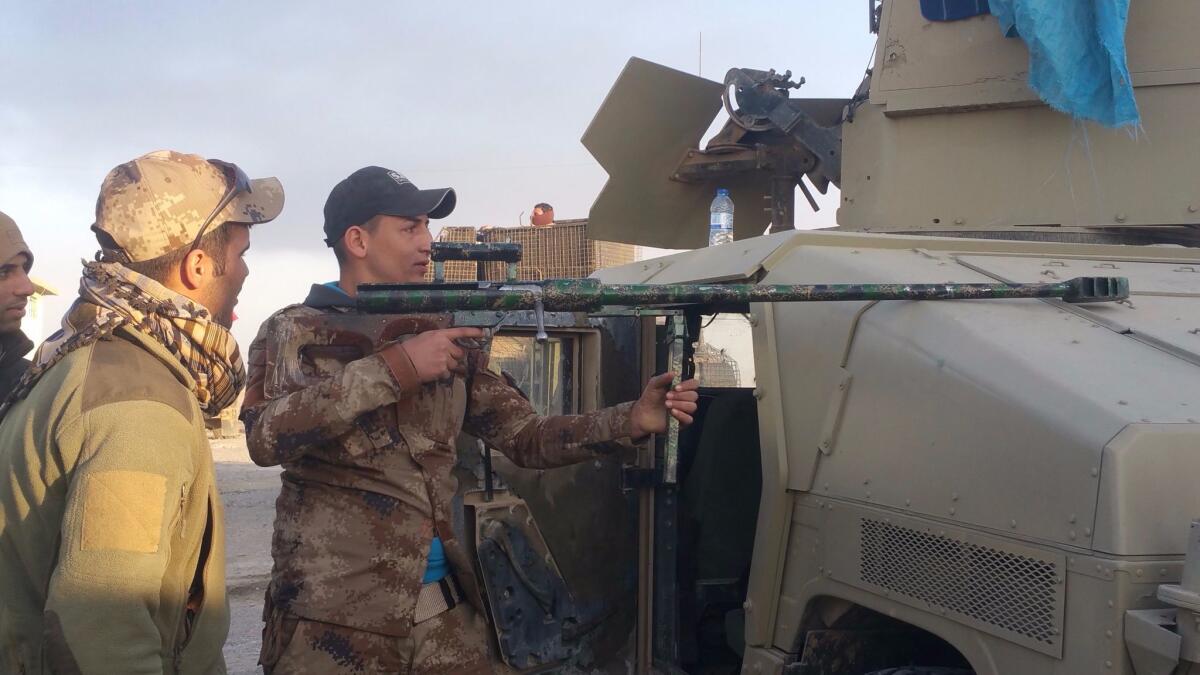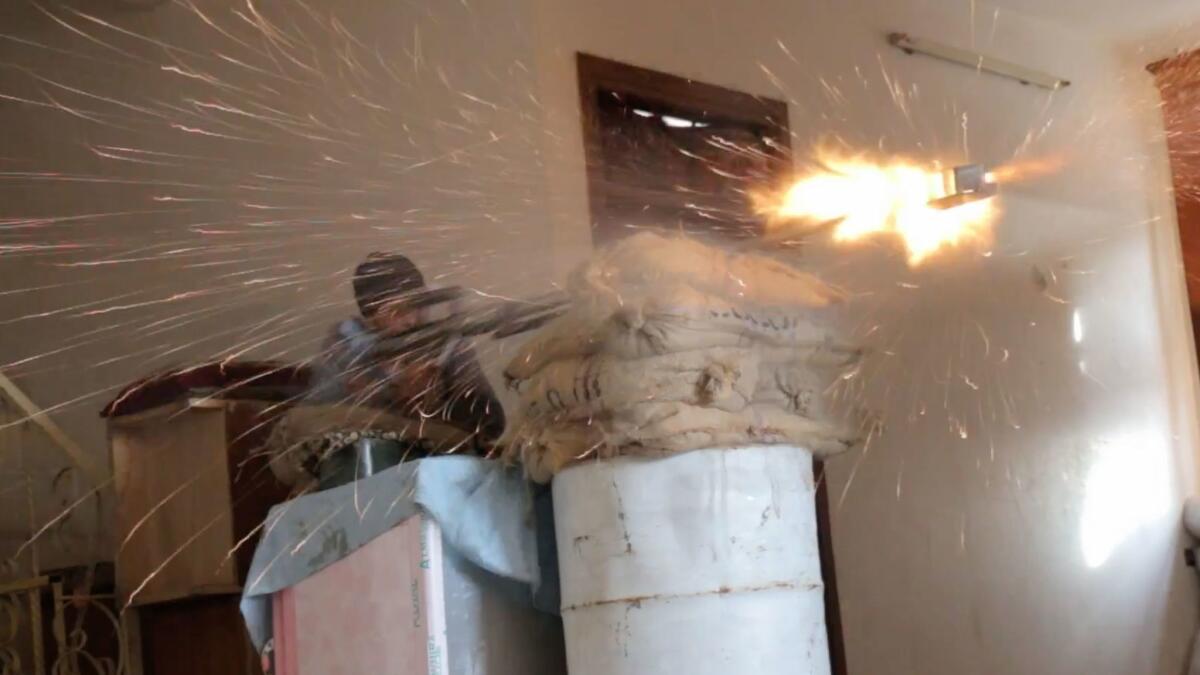As Iraqi forces storm Mosul’s Old City quarter, a desperate Islamic State strikes back
- Share via
During the last eight months, Iraqi forces have fought to corner
Troops this week began the long-anticipated assault on the Old City quarter, the last district still in the extremist group’s hands.
And Wednesday, officials said militants destroyed the iconic Nuri mosque, the site where Islamic State leader Abu Bakr Baghdadi declared the group’s caliphate three years ago.
As the pressure has increased around Mosul since the government offensive to retake it began Oct. 17, the fight has apparently transformed into a so-called cauldron battle, where the militants have no chance of escape. Their only options would be to surrender or die.
Several military officials and analysts expect the militants to make a last stand in the remaining one square mile of what had once been the crown jewel of their caliphate. Many officials estimate it will take more than a month to clear the area.
“The closer we’ve gotten to the Old City the more defenses we’re seeing,” said Col. Mounir Abdul Aziz, a commander with the Iraqi army’s 15th division, in a recent interview in west Mosul’s Zanjili neighborhood. “The problem is that now it’s a suicidal enemy. They don’t withdraw easily, unless they’re killed or wounded.”
The militant group on Saturday released a 34-minute video with footage of combat in Mosul and its preparations for battle.
According to one jihadi in the video, they would accept only one of two outcomes: “Either it is victory from Allah … or a martyrdom through which we enter paradise.”
Security forces have estimated that about 500 militants are holed up in the Old City.
The Old City’s densely packed buildings and narrow walkways require more troops than other locations to ferret out jihadis, said David Eubank, a former U.S. special forces soldier turned aid worker who is traveling with the Iraqi army’s 9th division.
“In normal assault situations, you need three soldiers to every militant. But in a place like this it requires seven to one, maybe even 10 to one,” Eubank said in an interview.
Nasser Nayef, an Iraqi Counter-Terrorism Service soldier, said the resistance would only get more difficult.
“What happens when you corner a cat? It scratches,” he said.
Islamic State has, in fact, adopted various tactics to stall the Iraqi troops’ advance. Here’s a look at some of them:
Snipers

The extremists have had more than three years to prepare for the assault on the Old City and have set up what soldiers say are well thought-out sniper lanes where troops are expected to come in.
An attack Sunday by Iraqi forces showed that Islamic State militants had chosen their sniper positions well. As Iraqi troops’ Humvees rolled toward the outer perimeter of the Old City, a commander’s voice sputtered out of the radio.
“Gunners get down. Get down,” he ordered.
Islamic State snipers were trying to pick off the gunners as they peeked out of their machine-gun nests to give suppressing fire.
Shouts erupted on the radio after one gunner caught a bullet in the shoulder and was swiftly evacuated to a medical station away from the front line.
Soldiers say the positions are well protected, placing the sniper behind a small hole in the wall of a building or even several rooms away from a structure’s outer wall to provide protection from strikes.
The group’s videos show the militants using not only standard scoped rifles, but also long-barreled weapons it has manufactured with a range up to almost 1,000 yards, soldiers say.

Heavy machine guns and rockets
The moment the Iraqi troops’ bulldozers began to breach ersatz barricades made of masonry and crumpled cars, the rat-tat-tat of heavy machine guns broke through the stillness of the morning Sunday, peppering the incoming troops with bullets.
With nothing left to lose, the militants have brought all the weapons they have to bear, said Lt. Col. Mohammed Tamimi, a battalion commander in the Counter-Terrorism Service.
As he spoke, bullets smacked the fence of the house where he had set up his mobile command center. The jihadis were less than 300 yards away.
“They’re shooting 23 mm guns to stop us,” Tamimi said. “That’s what you use to hit aircraft.”
Elsewhere on the front line, troops have found caches of Swedish-made antitank grenade launchers that were supplied to the Iraqi military by the U.S. but were scooped up by Islamic State when it took over Mosul in 2014, as well as antitank guided missiles.
‘Mouse-holing’
Whether through warplanes or commercial drones, the U.S.-led coalition and Iraqi forces have many eyes in the sky over Mosul.
Once an Islamic State position is spotted, troops relay the coordinates to the coalition, which then conducts a strike in less than four minutes, said Col. Arkan Fadel, an Iraqi officer who coordinates airstrikes.
The intense surveillance has forced the militants to operate in small units of two- to five-man teams. They nimbly move through a network of holes punched in the walls between houses to avoid being seen from above.
The tunnels mean security forces must move in a coordinated line to stop the militants.
“I have to wait for the other units to come and secure both sides of where I am before I can go forward,” Lt. Col. Salam Obaidi of the Counter-Terrorism Service said Monday. “That’s why we’re advancing like turtles.”
Inghimasis and suicide bombers
The early stages of the fight for Mosul saw Islamic State dispatch scores of suicide car bombs at the incoming forces. Using drones, the militants would direct drivers to avoid barriers set up by troops.
But the close-quarters combat and narrow streets of the Old City have led the group to shift to what are known as inghimasis, gunmen who rush at their enemy, fighting to the last bullet and grenade before detonating their suicide belts.
Last week, soldiers of the Iraqi army’s 9th division battled for control of the Shifaa neighborhood, which is next to the Old City. They had halted the advance for the day and had secured the street where they would spend the night — or so they thought.
Five suicide bombers ran at them, but none made it close enough to detonate their belts.
“One in the street, three in the mosque, another Daesh in this building here,” said Brig. Gen. Mustafa Sabah, a brigade commander with the 9th division. Daesh is the Arabic acronym for Islamic State.
“These guys want to die and my soldiers want to live. How do you counter that?”
Using residents as human shields
About 700,000 people have fled Mosul, once Iraq's second-largest city with a population of 1.2 million. But an estimated 100,000 to 150,000 people still live in the Old City.
Security services have long accused Islamic State of using civilians as human shields and forcing residents to stay with the militants as they retreat to areas still under their control.
That issue has been compounded in Mosul, where the Iraqi government urged residents to stay in their homes during the offensive in a bid to reduce the number of those displaced.
In the Old City quarter troops are bound to engage in house-to-house fighting with militants hiding among civilians.
The buildings there are older, residents say, and liable to collapse even if not directly targeted. Military planners say they are doing everything they can to prevent civilian deaths.
“We are using less powerful ordnance in our strikes,” Lt. Gen. Abdul Wahab Saadi, deputy head of the Iraqi counter-terrorism forces, said in an interview.
Several residents interviewed last week spoke of dozens of people killed in the strikes.
Those lucky enough to survive the airstrikes still face the prospect of being hit by stray bullets, even as the militants massacre those who are fleeing the carnage. In a recent incident, hundreds were cut down by Islamic State snipers near Mosul’s Pepsi factory.
Those who flee tell of a desperate existence for those trapped inside the Old City.
“There was no fresh water inside. We sold our gold to afford to buy 6 jerrycans filled with water for $130,” said Maha Ghanem Salem, a resident fleeing from Shifaa neighborhood last week.
When her husband, a vegetable porter named Ali Salem, went to look for water, he caught sight of the soldiers. He quickly corralled his wife, his two sons and two daughters to make their escape.
“We have always worried that Iraqi civilians would pay a very high price and we have seen in the last few weeks that the number of civilians wounded and killed has increased, we fear, very sharply,” Lise Grande, the United Nations’ humanitarian coordinator, said in a phone interview. “What is facing all of us in the next few days is frightening to contemplate.”
Bulos is a special correspondent.
Sign up for Essential California
The most important California stories and recommendations in your inbox every morning.
You may occasionally receive promotional content from the Los Angeles Times.








